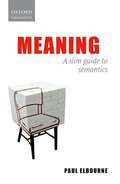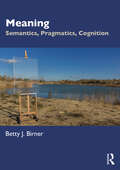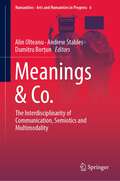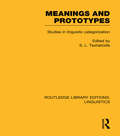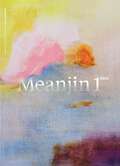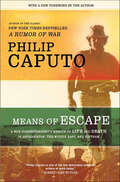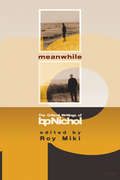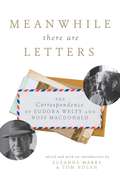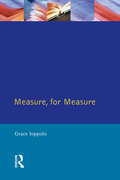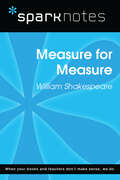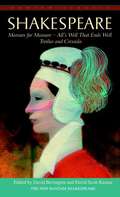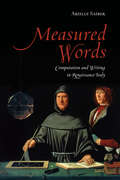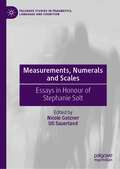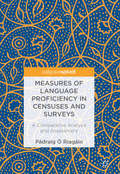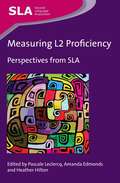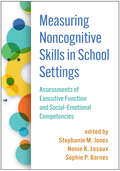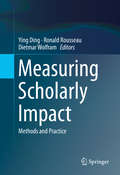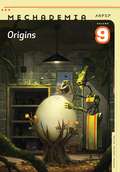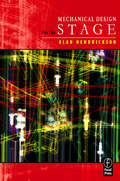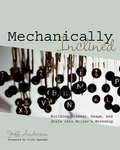- Table View
- List View
Meaning: A Slim Guide To Semantics
by Paul ElbourneThis book offers an introduction to the analysis of meaning. Our outstanding ability to communicate is a distinguishing feature of our species. To communicate is to convey meaning, but what is meaning? How do words combine to give us the meanings of sentences? And what makes a statement ambiguous or nonsensical? These questions and many others are addressed in Paul Elbourne's fascinating guide. He opens by asking what kinds of things the meanings of words and sentences could be: are they, for example, abstract objects or psychological entities? He then looks at how we understand a sequence of words we have never heard before; he considers to what extent the meaning of a sentence can be derived from the words it contains and how to account for the meanings that can't be; and he examines the roles played by time, place, and the shared and unshared assumptions of speakers and hearers. He looks at how language interacts with thought and the intriguing question of whether what language we speak affects the way we see the world. Meaning, as might be expected, is far from simple. Paul Elbourne explores its complex issues in crystal clear language. He draws on approaches developed in linguistics, philosophy, and psychology - assuming a knowledge of none of them -in a manner that will appeal to everyone interested in this essential element of human psychology and culture.
Meaning: Semantics, Pragmatics, Cognition
by Betty J. BirnerMeaning addresses the fundamental question of human language interaction: what it is to mean, and how we communicate our meanings to others. Experienced textbook writer and eminent researcher Betty J. Birner gives balanced coverage to semantics and pragmatics, emphasizing interactions between the two, and discusses other fields of language study such as syntax, neurology, philosophy of language, and artificial intelligence in terms of their interfaces with linguistic meaning. Comics and diagrams appear throughout to keep the reader engaged; and end-of-chapter quizzes, data-collection exercises, and opinion questions are employed along with more traditional exercises and discussion questions. In addition, the book features copious examples from real life and current events, along with boxes describing linguistic issues in the news and interesting and accessible research on topics like swearing, politics, and animal communication. Students will emerge ready for deeper study in semantics and pragmatics – and more importantly, with an understanding of how all of these fields serve the fundamental purpose of human language: the communication of meaning. Meaning is an ideal textbook for courses in linguistic meaning that focus on both semantics and pragmatics in equal parts, with special attention on philosophical questions, related subfields of linguistics, and interfaces among these various areas. Appropriate for both undergraduate and graduate-level courses in semantics, pragmatics, and general linguistics, Meaning is essential reading for all students of linguistic meaning.
Meanings & Co.: The Interdisciplinarity of Communication, Semiotics and Multimodality (Numanities - Arts and Humanities in Progress #6)
by Alin Olteanu Andrew Stables Dumitru BorţunThis book explores the interdisciplinarity of semiotics and communication studies, comprising both theoretical explorations and semiotic applications to communication with theoretical bearings. These disciplines have generally been understood as mutually implicit, but there still are many unexplored research avenues in this area, particularly on a conceptual level. The book offers broad insights into the epistemological relations between semiotics and other approaches to communication from perspectives such as sociology, philosophy of language and communication theory. As such, it sheds light on the communication of knowledge.Semiotics is currently enjoying increasing popularity within the humanities and social sciences. Understood as relational logic (Charles Peirce) or hermeneutics (structuralism and poststructuralism), semiotics fundamentally implies certain positions with regard to communication. Because of the generality and conceptual vagueness of semiosis and communication, how one elucidates the other is still an underexplored theme. With some pioneering studies of this relation, the books examines various fields, such as language, code, learning, embodiment, political communication, media, cinema, cuisine, multimodality and intertextuality.
Meanings and Prototypes: Studies in Linguistic Categorization (Routledge Library Editions: Linguistics)
by S. L. TsohatzidisThere are fewer distinctions in any language than there are distinct things in the universe. If, therefore, languages are ways of representing the universe, a primary function of their elements must be to allow the much more varied kinds of elements out of which the universe is made to be categorized in specific ways. A prototype approach to linguistic categories is a particular way of answering the question of how this categorization operates. It involves two claims. First, that linguistic categorization exploits principles that are not specific to language but characterize most, if not all, processes of cognition. Secondly, that a basic principle by which cognitive and linguistic categories are organized is the prototype principle, which assigns elements to a category not because they exemplify properties that are absolutely required of each one of its members, but because they exhibit, in varying degrees, certain types of similarity with a particular category member which has been established as the best example (or: prototype) of its kind. The development of the prototype approach into a satisfactory body of theory obviously requires both that its empirical base be enriched, and that its conceptual foundations be clarified. These are the areas where this volume, in its 26 essays, makes original contributions. The first two parts contain discussions in which various kinds of linguistic phenomena are analysed in ways that make essential use of prototype notions. The last two parts contain discussions in which prototype notions themselves become the object, rather than the instrument, of analytical scrutiny.
Meanjin Vol 73, No 1
by Meanjin QuarterlyThe March 2014 issue of Meanjin is full of outsiders, revolutionaries and dissenters. We discover a lost archive of photographs of Charmian Clift on and George Johnson on Hydra in an essay by Paul Genoni and Tanya Dalziell, while James Douglas take a look at the unique powers of persuasion employed by journalist and writer Anna Krien. In the Meanjin Papers essay, Paul Daley brings us the shocking history of Australia's unidentified Indigenous remains and we have a rich mix of memoir, fiction and poetry in this special bumper issue.
Means of Escape: A War Correspondent's Memoir of Life and Death in Afghanistan, the Middle East, and Vietnam
by Philip Caputo"A riveting memoir of years of living dangerously."—Kirkus ReviewsFor the countless readers who have admired Philip Caputo's classic memoir of Vietnam, A Rumor of War, here is his powerful recounting of his life and adventures, updated with a foreword that assesses the state of the world and the journalist's art. As a journalist, Caputo has covered many of the world's troubles, and in Means of Escape, he tells the reader in moving and clear-eyed prose how he made himself into a writer, traveler, and observer with the nerve to put himself at the center of the world's conflicts. As a young reporter he investigated the Mafia in Chicago, earning acclaim as well as threats against his safety. Later, he rode camels through the desert and enjoyed Bedouin hospitality, was kidnapped and held captive by Islamic extremists, and was targeted and hit by sniper fire in Beirut, with memories of Vietnam never far from the surface. And after it all, he went into Afghanistan. Caputo's goal has always been to bear witness to the crimes, ambitions, fears, ferocities, and hopes of humanity. With Means of Escape, he has done so.
Meanwhile
by Bp Nichol Roy MikiRepresenting a substantial collection of bpNichol's critical writing from the mid-1960s to the year of his death, 1988, Meanwhile puts him on the vanguard of Canadian literature and critical theory. This collection is essential to our sense of Nichol not only as a writer, but also as a person of exemplary generosity, imagination and intellectual range.
Meanwhile There Are Letters: The Correspondence of Eudora Welty and Ross Macdonald
by Suzanne Marrs Tom NolanIn 1970, Ross Macdonald wrote a letter to Eudora Welty, beginning a thirteen-year correspondence between fellow writers and kindred spirits. Though separated by background, geography, genre, and his marriage, the two authors shared their lives in witty, wry, tender, and at times profoundly romantic letters, each drawing on the other for inspiration, comfort, and strength. They brought their literary talents to bear on a wide range of topics, discussing each others' publications, the process of translating life into fiction, the nature of the writer’s block each encountered, books they were reading, and friends and colleagues they cherished. They also discussed the world around them, the Vietnam War, the Nixon, Carter, and Reagan presidencies, and the environmental threats facing the nation. The letters reveal the impact each had on the other’s work, and they show the personal support Welty provided when Alzheimer’s destroyed Macdonald’s ability to communicate and write. The editors of this collection, who are the definitive biographers of these two literary figures, have provided extensive commentary and an introduction. They also include Welty’s story fragment "Henry,” which addresses Macdonald’s disease. With its mixture of correspondence and narrative, Meanwhile There Are Letters provides a singular reading experience: a prose portrait of two remarkable artists and one unforgettable relationship.
Measure For Measure: The Folio of 1623
by William Shakespeare Grace IoppoloThe Shakespearean Originals Series takes as its point of departure the question: "What is it that we read Shakespeare?" The answer may seem self-evident: we read the words that Shakespeare wrote. But do we? In the case of all the major editions of Shakespeare available in the market, the fact of the matter is that many of the words that we read in an edition of, say, Hamlet, never appeared in the text as it was printed during or shortly after Shakespeare's own lifetime. They are the interpetations and interpolations of a series of editors who have been systematically changing Shakespeare's text from the eighteenth century onwards. This volume offers the text of Measure for Measure, as printed in the 1623 First Folio.
Measure for Measure (SparkNotes Literature Guide Series)
by SparkNotesMeasure for Measure (SparkNotes Literature Guide) by William Shakespeare Making the reading experience fun! Created by Harvard students for students everywhere, SparkNotes is a new breed of study guide: smarter, better, faster. Geared to what today's students need to know, SparkNotes provides: *Chapter-by-chapter analysis *Explanations of key themes, motifs, and symbols *A review quiz and essay topicsLively and accessible, these guides are perfect for late-night studying and writing papers
Measure for Measure, Troilus and Cressida, and All's Well That Ends Well
by William Shakespeare David Bevington David Scott Kastan James Hammersmith Robert Kean Turner Joseph PappAn exciting new edition of the complete works of Shakespeare with these features: Illustrated with photographs from New York Shakespeare Festival productions, vivid readable readable introductions for each play by noted scholar David Bevington, a lively personal foreword by Joseph Papp, an insightful essay on the play in performance, modern spelling and pronunciation, up-to-date annotated bibliographies, and convenient listing of key passages.
Measured Words: Computation and Writing in Renaissance Italy
by Arielle SaiberMeasured Words investigates the rich commerce between computation and writing that proliferated in fifteenth- and sixteenth-century Italy. Arielle Saiber explores the relationship between number, shape, and the written word in the works of four exceptional thinkers: Leon Battista Alberti’s treatis on cryptography, Luca Pacioli’s ideal proportions for designing Roman capital letters, Niccolò Tartaglia’s poem embedding his solution to solving cubic equations, and Giambattista Della Porta’s curious study on the elements of geometric curves. Although they came from different social classes and practiced the mathematical and literary arts at differing levels of sophistication, they were all guided by a sense that there exist deep ontological and epistemological bonds between computational and verbal thinking and production. Their shared view that a network or continuity exists between the arts yielded extraordinary results. Through measuring their words, literally and figuratively, they are models of what the very best interdisciplinary work can offer us.
Measurements, Numerals and Scales: Essays in Honour of Stephanie Solt (Palgrave Studies in Pragmatics, Language and Cognition)
by Nicole Gotzner Uli SauerlandThis book brings together chapters on the semantics and pragmatics of measurement, scales, and numerical expressions. The chapters highlight recent developments in measurement theory, the meaning of numerical expressions and the relation between measurement scales and entailment scales. The authors provide explorations in formal and experimental semantics and pragmatics, as well as at the interfaces of this field with others including philosophy of language and sociolinguistics. This book will be of interest to students and scholars in these areas, as well as psychology, psycholinguistics and artificial intelligence.
Measures of Language Proficiency in Censuses and Surveys: A Comparative Analysis and Assessment
by Pádraig Ó RiagáinThis book offers a systematic analysis of a wide range of questions used in censuses, national surveys and international surveys to measure language proficiency. It addresses the urgent need in language related survey research for a comprehensive examination of the large existing body of survey data in order to provide a fuller understanding of the extent to which survey results are shaped by the way language proficiency questions are worded. While census and survey language proficiency data are extensively used in a wide range of research areas, as well as in forming, implementing and monitoring government policies, there are as yet no universally accepted survey measures of language proficiency. This book will therefore provide a valuable resource for students and scholars working in sociological areas that use census or survey language data, such as sociology of language, sociology of education, politics, racial and ethnic studies, and cultural studies; as well as for policy analysts.
Measuring L2 Proficiency
by Amanda Edmonds Pascale LeclercqThe creation of the Common European Framework of Reference for Languages (CEFR) has given rise to interest and debate among policy makers, testers, teachers and researchers alike in the reliability and feasibility of the assessment of second language (L2) proficiency. This volume brings together concrete ideas on identifying and measuring L2 proficiency from different branches of SLA research (psycholinguistic, sociolinguistic, corpus-based, applied linguistics) to contribute to a deeper understanding of what it means to be proficient in an L2. The chapters introduce a wide range of tools that are innovative, reliable, and easy-to-use for the evaluation of learners' language level with respect to both productive and receptive skills and provide a variety of answers to the question of how to assess L2 proficiency in a valid, reliable and practical manner. The collection will therefore inspire language teachers, teacher trainers and language testing specialists and help them adapt their assessment practices when necessary, and will also be a valuable resource for postgraduate students and researchers.
Measuring Noncognitive Skills in School Settings: Assessments of Executive Function and Social-Emotional Competencies
by Stephanie M. Jones, Nonie K. Lesaux and Sophie P. BarnesChildren's social–emotional and self-regulation skills are critical for success in school and, ultimately, in the workplace. How can educators determine the most effective approaches for measuring students' interpersonal competencies? And how can they use the data to improve their own practice? Relevant for school leaders, educators, researchers, and other stakeholders, this book brings together leading experts from multiple disciplines to discuss the current state of measurement and assessment of a broad range of noncognitive skills and present an array of innovative tools. Chapters describe measures targeting the individual student, classroom, whole school, and community; highlight implications for instructional decision making; examine key issues in methodology, practice, and policy; and share examples of systematic school- and districtwide implementation.
Measuring Psychological Responses to Media Messages (Routledge Communication Series)
by Annie LangCharacterized by its multi-level interdisciplinary character, communication has become a variable field -- one in which the level of analysis varies. This has had important ramifications for the study of communication because, to some extent, the questions one asks are determined by the methods one has available to answer them. As a result, communication research is characterized by the plethora of both qualitative and quantitative approaches used by its practitioners. These include survey and experimental methods, and content, historical, and rhetorical analyses. A variety of tools has been developed in cognitive psychology and psychophysiology which attempts to measure "thinking" without asking people how they do it. This book is devoted to exploring how these methods might be used to further knowledge about the process of communication. The methods chosen have all been used extensively in cognitive and experimental psychology. Each chapter in this book is designed to describe the history of the method being introduced, the theory behind it, how to go about using it, and how it has already been used to study some area of communication. The methods introduced here vary widely in terms of the amount of equipment and training needed to use them. Some require only theoretical knowledge and a paper and pencil; others require more elaborate hardware and software for implementation. These methods also vary widely in terms of what sorts of variables they can be used to measure. Some of them adapt quite readily to traditional communication variables like persuasion, attitude change, and knowledge; others are more applicable to process type variables such as attention, arousal, involvement, encoding, and retrieval.
Measuring Scholarly Impact
by Ying Ding Ronald Rousseau Dietmar WolframThis book is an authoritative handbook of current topics, technologies and methodological approaches that may be used for the study of scholarly impact. The included methods cover a range of fields such as statistical sciences, scientific visualization, network analysis, text mining, and information retrieval. The techniques and tools enable researchers to investigate metric phenomena and to assess scholarly impact in new ways. Each chapter offers an introduction to the selected topic and outlines how the topic, technology or methodological approach may be applied to metrics-related research. Comprehensive and up-to-date, Measuring Scholarly Impact: Methods and Practice is designed for researchers and scholars interested in informetrics, scientometrics, and text mining. The hands-on perspective is also beneficial to advanced-level students in fields from computer science and statistics to information science.
Measuring Up to the English I End-of-Course Exam, Texas STAAR Edition
by Peoples Education"The lessons in this English I worktext are geared towards helping you master the TEKS so that you are well prepared for the Texas STAAR End-of-Course exam. EOC English I
Measuring Up to the New York P-12 Common Core Learning Standards-English Language Arts, Level H
by Mastery EducationThis program helps prepare students for the rigorous expectations of the New York State Test for English Language Arts. This book is divided into three units that cover the four main categories in English Language Arts. Language - Unit 1; Writing - Unit 1; Reading Literature - Unit 2; and Reading Informational Text - Unit 3. There are many opportunities in this book to help your child practice reading.
Mechademia 3: Limits of the Human
by Frenchy LunningDramatic advances in genetics, cloning, robotics, and nanotechnology have given rise to both hopes and fears about how technology might transform humanity. As the possibility of a posthuman future becomes increasingly likely, debates about how to interpret or shape this future abound. In Japan, anime and manga artists have for decades been imagining the contours of posthumanity, creating dazzling and sometimes disturbing works of art that envision a variety of human/nonhuman hybrids: biological/mechanical, human/animal, and human/monster. Anime and manga offer a constellation of posthuman prototypes whose hybrid natures require a shift in our perception of what it means to be human.Limits of the Human—the third volume in the Mechademia series—maps the terrain of posthumanity using manga and anime as guides and signposts to understand how to think about humanity&’s new potentialities and limits. Through a wide range of texts—the folklore-inspired monsters that populate Mizuki Shigeru&’s manga; Japan&’s Gothic Lolita subculture; Tezuka Osamu&’s original cyborg hero, Atom, and his manga version of Fritz Lang&’s Metropolis (along with Ôtomo Katsuhiro&’s 2001 anime film adaptation); the robot anime, Gundam; and the notion of the uncanny in Ghost in the Shell 2: Innocence, among others—the essays in this volume reject simple human/nonhuman dichotomies and instead encourage a provocative rethinking of the definitions of humanity along entirely unexpected frontiers. Contributors: William L. Benzon, Lawrence Bird, Christopher Bolton, Steven T. Brown, Joshua Paul Dale, Michael Dylan Foster, Crispin Freeman, Marc Hairston, Paul Jackson, Thomas LaMarre, Antonia Levi, Margherita Long, Laura Miller, Hajime Nakatani, Susan Napier, Natsume Fusanosuke, Sharalyn Orbaugh, Ôtsuka Eiji, Adèle-Elise Prévost and MUSEbasement; Teri Silvio, Takayuki Tatsumi, Mark C. Taylor, Theresa Winge, Cary Wolfe, Wendy Siuyi Wong, and Yomota Inuhiko.
Mechademia 9: Origins (Mechademia #9)
by Frenchy LunningIf the source of manga and anime is physically located in Japan, the temptation for many critics and scholars is to ask what aspects of Japanese culture and history gave rise to these media. This ninth volume of Mechademia—an annual collection of critical work on anime and manga—challenges the tendency to answer the question of origins by reductively generalizing and essentializing &“Japaneseness.&” The essays brought together in Mechademia 9 lead us to understand the extent to which &“Japan&” might be seen as an idea generated by anime, manga, and other texts rather than the other way around. What is it that manga and anime produce that no other medium can precisely duplicate? Is anime its own medium or a genre of animation—or something in between? And how must we adapt existing critical modes in order to read these new kinds of texts? While the authors begin with similar questions about the roots of Japanese popular culture and media, they invoke a wide range of theoretical work in the search for answers, including feminist criticism, disability studies, poststructuralist textual criticism, postcolonialism, art history, film theory, phenomenology, and more. Richly provocative and insightful, Mechademia 9 both enacts and resists the pursuit of fixed starting points, inspiring further creative investigation of this global artistic phenomenon.Contributors: Stephen R. Anderson; Dale K. Andrews, Tohoku Gakuin U; Andrew Ballús; Jodie Beck; Christopher Bolton, Williams College; Kukhee Choo, Tulane U; Ranya Denison, U of East Anglia; Lucy Fraser; Fujimoto Yukari, Meiji U, Japan; Forrest Greenwood; Imamura Taihei; Seth Jacobowitz, Yale U; Kim Joon Yang; Thomas Lamarre, McGill U; Margherita Long, U of California, Riverside; Matsumoto Nobuyuki, Tokyo National Museum; Laura Miller, U of Missouri–St. Louis; Alexandra Roedder; Paul Roquet, Stanford U; Brian Ruh; Shun&’ya Yoshimi, U of Tokyo; Alba G. Torrents.
Mechanical Design for the Stage
by Alan HendricksonScenic effects involving rotating turntables, tracking stage wagons, and the vertical movement of curtains and painted drops have become common in both Broadway and Regional theatre productions. The machines that drive these effects range from small pneumatic cylinders pushing loads of a few pounds an inch or two, to 40 horsepower winches running multi-ton scenery at speeds 6 feet per second or more. Usually this machinery is designed by theatre technicians specifically for a particular show's effect. Compared to general industry, this design process is short, often only a few days long, it is done by one person, design teams are rare, and it is done in the absence of reference material specifically addressing the issues involved. The main goal of this book is to remedy this last situation.Mechanical Design for the Stage will be a reference for you that will:* provide the basic engineering formulas needed to predict the forces, torques, speeds, and power required by a given move* give a technician a design process to follow which will direct their work from general concepts to specific detail as a design evolves, and* show many examples of traditional stage machinery designs.The book's emphasis will be on following standard engineering design and construction practices, and developing machines that are functional, efficient to build, easily maintained, and safe to use.
Mechanically Inclined: Building Grammar, Usage, And Style Into Writer's Workshop
by Jeff AndersonMechanically Inclined is the culmination of years of experimentation that merges the best of writer's workshop elements with relevant theory about how and why skills should be taught. It connects theory about using grammar in context with practical instructional strategies, explains why kids often don't understand or apply grammar and mechanics correctly, focuses on attending to the "high payoff,” or most common errors in student writing, and shows how to carefully construct a workshop environment that can best support grammar and mechanics concepts. Jeff emphasizes four key elements in his teaching: short daily instruction in grammar and mechanics within writer's workshop; using high-quality mentor texts to teach grammar and mechanics in context; visual scaffolds, including wall charts, and visual cues that can be pasted into writer's notebooks; regular, short routines, like "express-lane edits,” that help students spot and correct errors automatically. Comprising an overview of the research-based context for grammar instruction, a series of over thirty detailed lessons, and an appendix of helpful forms and instructional tools, Mechanically Inclined is a boon to teachers regardless of their level of grammar-phobia. It shifts the negative, rule-plagued emphasis of much grammar instruction into one which celebrates the power and beauty these tools have in shaping all forms of writing.
Mechanically Inclined: Building Grammar, Usage, and Style into Writer's Workshop
by Jeff Anderson Lisa ThibodeauxSome teachers love grammar and some hate it, but nearly all struggle to find ways of making the mechanics of English meaningful to kids. As a middle school teacher, Jeff Anderson also discovered that his students were not grasping the basics, and that it was preventing them from reaching their potential as writers. Jeff readily admits, “I am not a grammarian, nor am I punctilious about anything,” so he began researching and testing the ideas of scores of grammar experts in his classroom, gradually finding successful ways of integrating grammar instruction into writer's workshop.Just in time for its 20th anniversary, this long awaited second edition of Mechanically Inclined continues to merge the best of writer's workshop elements with relevant theory about how and why skills should be taught. It connects theory about using grammar in context with practical instructional strategies, explains why kids often don't understand or apply grammar and mechanics correctly, focuses on attending to the “high payoff,” or most common errors in student writing, and shows how to carefully construct a workshop environment that can best support grammar and mechanics concepts. In this new edition, longtime colleague, Lisa Thibodeaux joins Jeff in emphasizing four key elements for grammar instruction: short daily instruction in grammar and mechanics within writer's workshop; using high-quality mentor texts to teach grammar and mechanics in context; visual scaffolds, including wall charts, and visual cues that can be pasted into writer's notebooks; regular, short routines, like “express-lane edits,” that help students spot and correct errors automatically. Comprising an overview of the research-based context for grammar instruction, a series of over forty detailed lessons, updated research, compelling new mentor texts, and an appendix of helpful forms and instructional tools, Mechanically Inclined is a boon to teachers regardless of their level of grammar-phobia. It shifts the negative, rule-plagued emphasis of much grammar instruction into one which celebrates the power and beauty these tools have in shaping all forms of writing.
